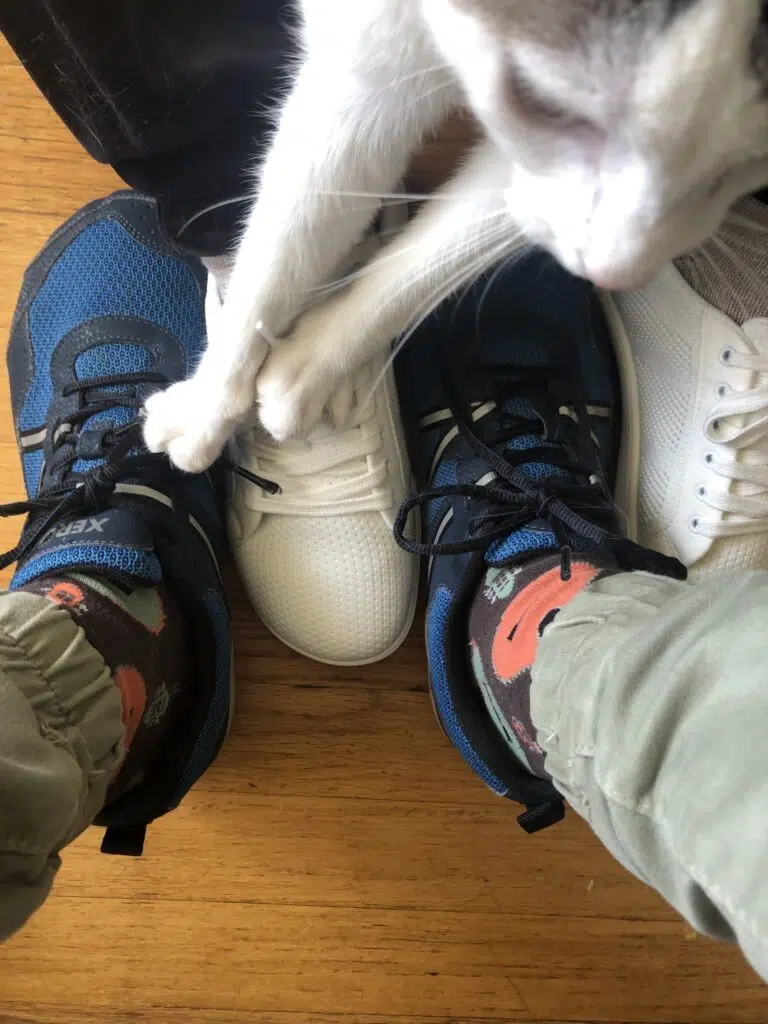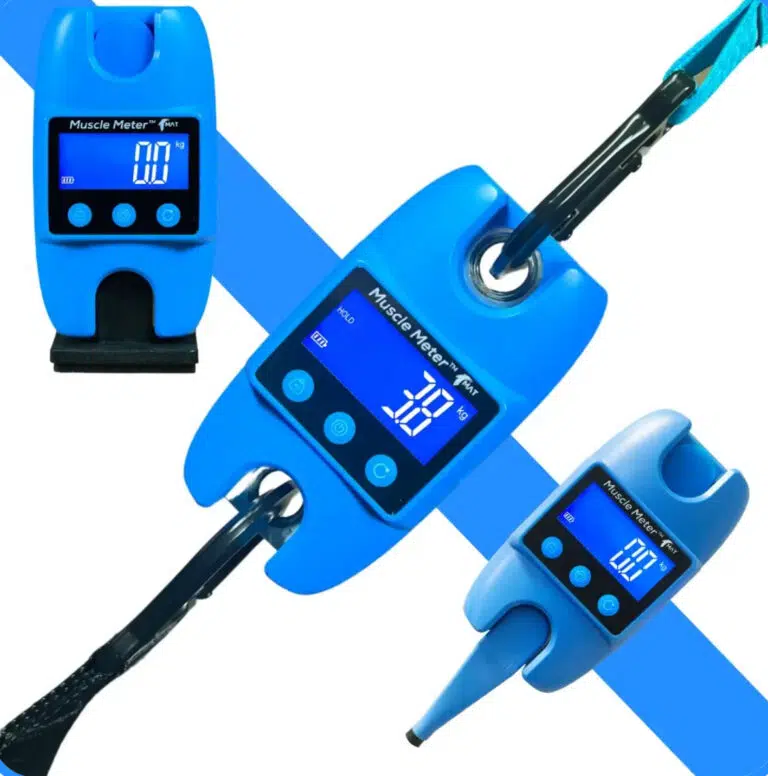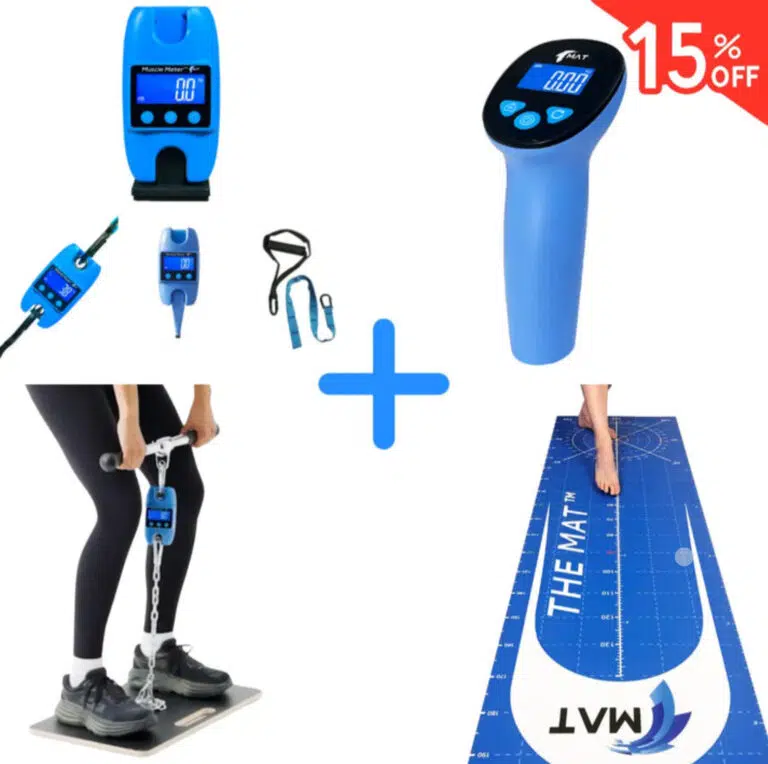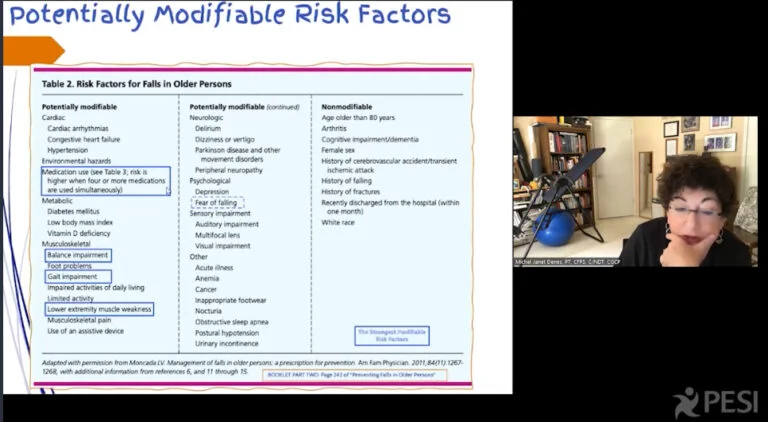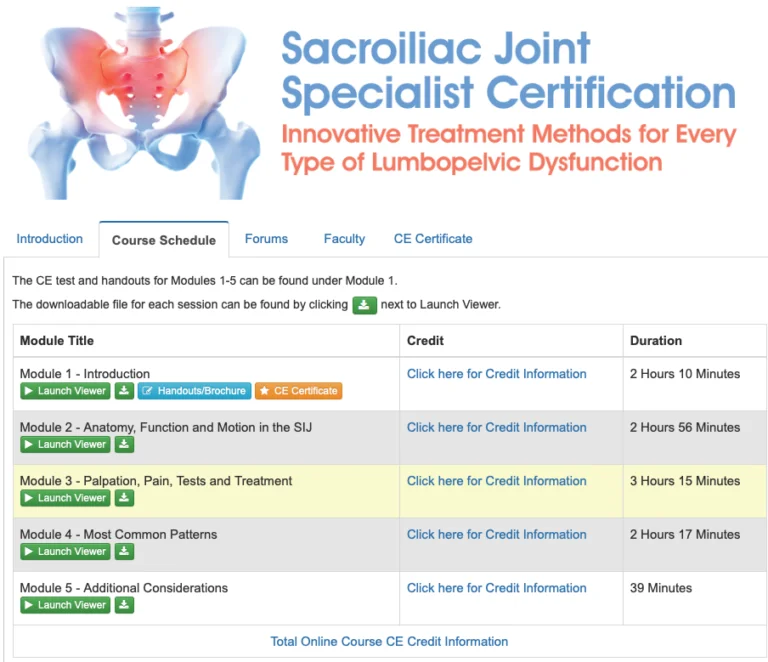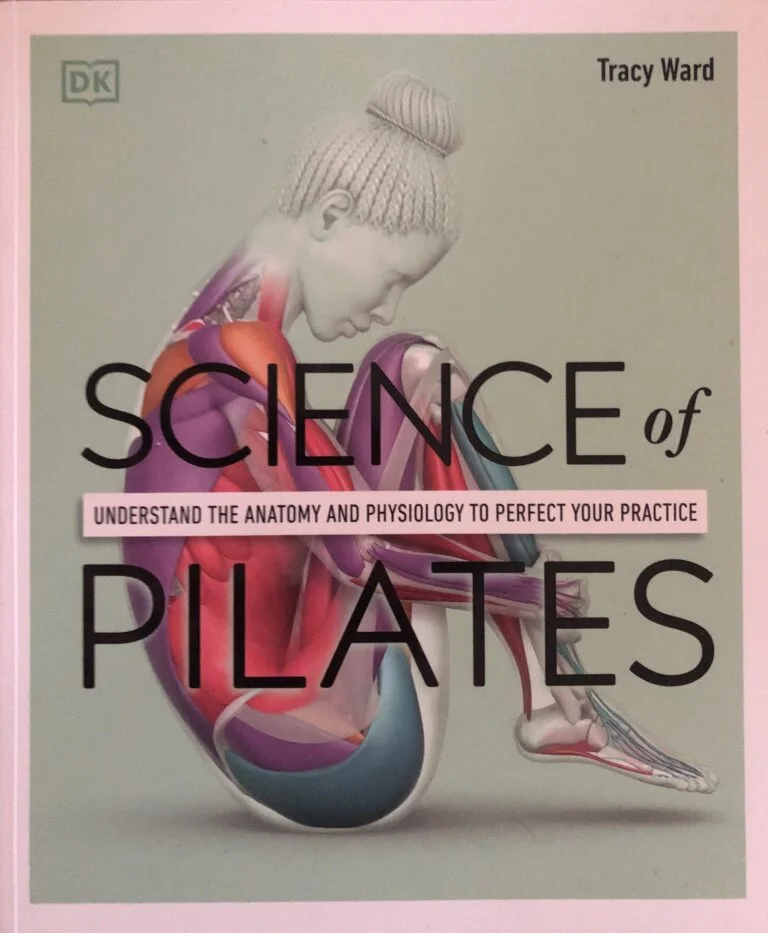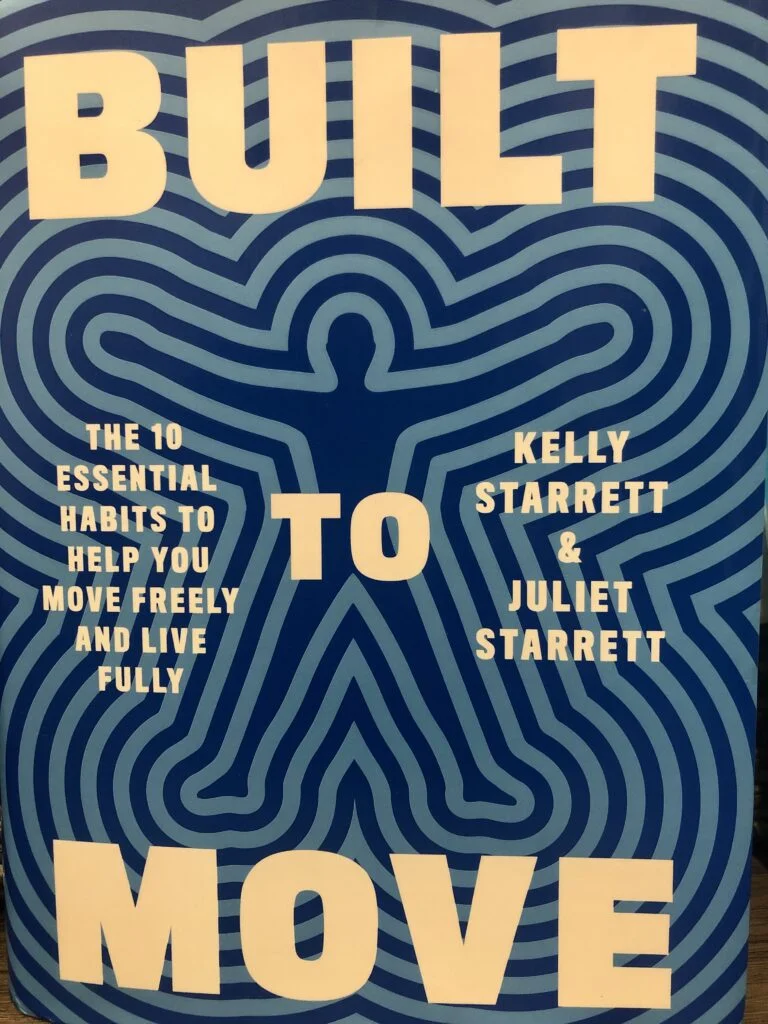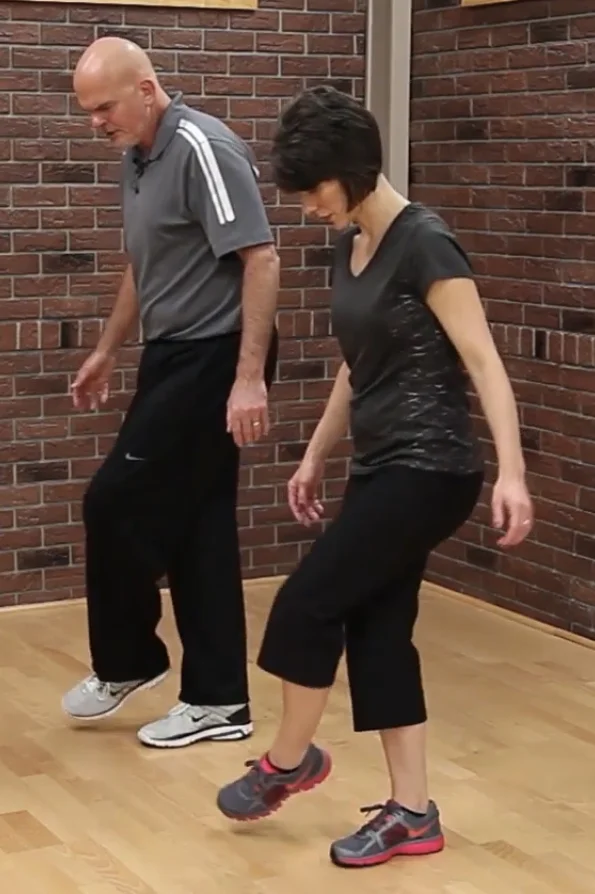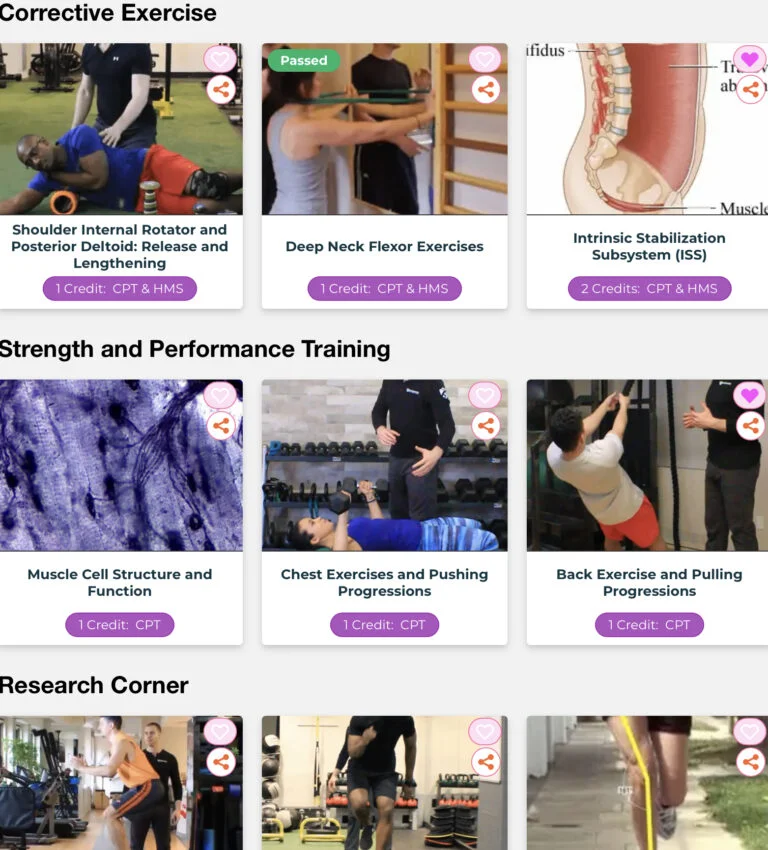There are a number of exercises and stretches that claim to treat sacroiliac joint pain, but the Sacroiliac Joint Specialist certification is not only perfect for professionals whose patients have sacroiliac pain. It also teaches PT-approved at-home treatment for sacroiliac pain that can be practiced by anyone.
The course teaches the most accurate method for diagnosing the actual cause and prescribing the most powerful treatment for sacroiliac pain.

SPECIAL MARCH 2025 50% DISCOUNT! USE OUR LINKS GET THE SACROILIAC JOINT COURSE FOR ONLY $99!!
This review of the Sacroiliac Joint Specialist Certification: Innovative Treatment Methods for Every Type of Lumbopelvic Dysfunction shows you why it stands head and shoulders above other approaches to sacroiliac pain.
The Hesch Institute’s Sacroiliac Joint Specialist Certification provides comprehensive information regarding safe, successful treatment of sacroiliac dysfunction, including:
- sciatica
- low back pain
- pelvic discomfort and inhibition
- General hip pain
The Sacroiliac Joint Specialist Certification is well-organized, uses leading contemporary research, and is informed by significant clinical experience.
The course instructor, Dr. Jerry Hesch, has a doctorate in physical therapy, masters degree in science, and is an authority in sacroiliac joint treatment.
In this review of the Sacroiliac Joint Specialist Certification, you’ll learn about sacroiliac joint dysfunction and how you can become the local expert in treating it.
As a sneak preview, we love that you can use this certification to learn to treat your own sacroiliac joint pain!
Overview of the Sacroiliac Joint Specialist Certification
The Hesch Institute’s Sacroiliac Joint Specialist Certification gives an overview of the anatomy, research, and recommended treatment of the entire pelvis (not just the sacroiliac joint). This is because the Hesch Method doesn’t really regard so-called sacroiliac joint pain (SIJP) as constrained to or usually even caused by the sacroiliac joint itself. Understanding the SIJ’s role within the entire pelvis is central to sucessful treatment.
The course is divided into four primary sections:
- Anatomy: using images, models, and guided palpation
- Screening the hips and sacroiliac joint for symmetry and joint function
- Protocols for treatment
- Relevant research: including anatomy, innervation, review of treatment results, and contraindications

The material is presented by video lectures and also has an excellent 300-page handbook with many illustrations and references. You can use PESI’s app to download the material and watch offline, which is perfect for long flights. Dr. Hesch is a clear lecturer, and there are lengthy tutorials with live models where Dr. Hesch comments while he’s working with a client.
Our sacroiliac joint specialist review also loves the attention to the latest research into sacroiliac joint pain. Dr. Hesch’s thorough research and decades of clinical work enable him to help you get your patients better fast, and there’s heaps of mandibular-dropping, myth-busting content (read below about that).
Why Choose this Sacroiliac Joint Certification?
The sacroiliac joint is a major area of pain and discomfort for many people. There are a number of approaches, methods, and treatments available, but how should one choose between them? Our sacroiliac joint certification review recommends PESI’s Sacroiliac Joint Specialist Certification based on a few factors:
- Evidence-based: making use of significant research, including most recent reviews.
- Clinically-informed: drawing from hours and years dealing with clients with a variety of issues and responses to treatment
- Well-organized: video content and manual are clearly divided
- Amazing additional free resources: free 300-page handbook with waivers, homework, and review sheets; free access to the additional advanced material (after certification); free listing on the Hesch website as a certified SIJ specialist.
- Learn pain-relieving techniques even without completing the entire certification.
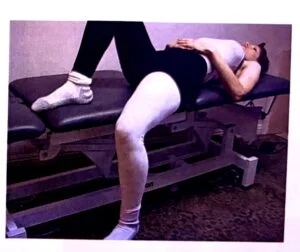
Additionally, there are aspects of the Hesch Method’s approach to sacroiliac pain and pelvic alignment that are available to non-medical teachers and coaches. This is because the heart of the method lies with gentle stretches that your clients can perform at home.
What is Sacroiliac Joint Pain?
Sacroiliac joint pain is felt in the connection between the pelvis and the sacrum (toward the inner, upper edge of the butt cheek). You can read a little more about sacroiliac pain here.
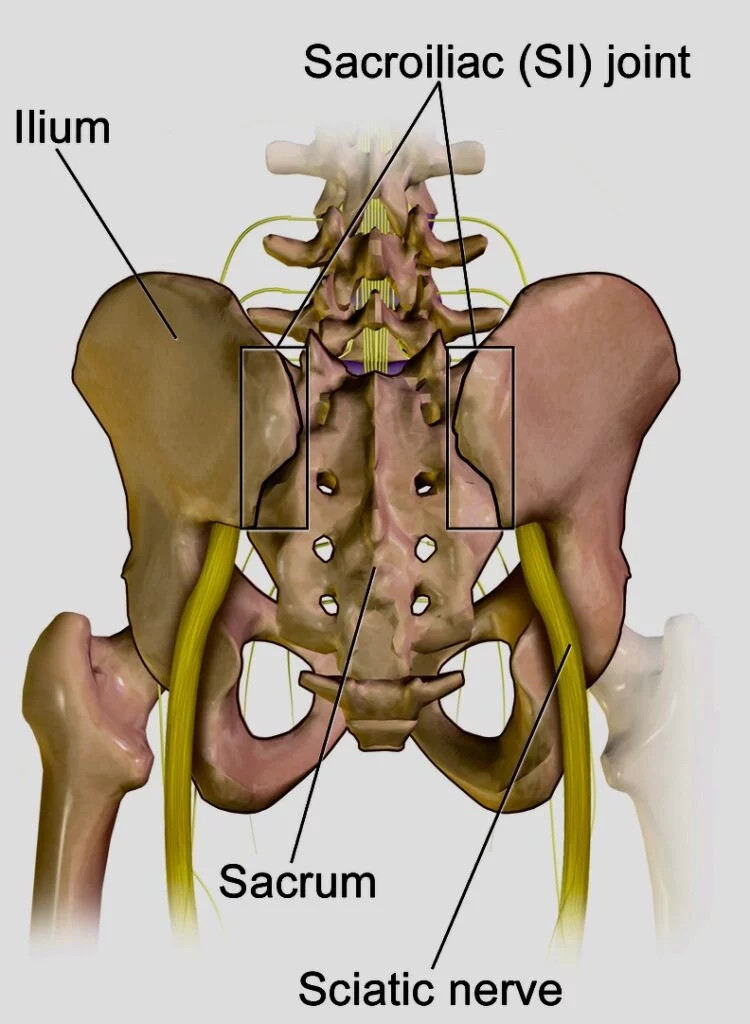
Pain in this area may be caused by the sacroiliac joint, or it may be referred pain stemming from another area, such as the low back.
The pain may be due to compression in the joint or uneven pressure or friction due to misalignment.
In the Sacroiliac Joint Pain certification, Dr. Hesch teaches a number of methods to find and treat the causes of sacroiliac joint pain.
Effective treatment for sacroiliac pain can be performed at home. The stretches you learn in this course are gentle and relaxing. Plus, you don’t need to buy any expensive equipment.
Who is Dr. Jerry Hesch?
Dr. Hesch is a physical therapist (DPT, PT) with over 40 years of experience in the clinic. Additionally, he has earned a Masters degree in Health Science and a doctorate in physical therapy. Dr. Hesch is founder of the Hesch Institute, which provides online and in-person training in his system, called the Hesch Method.
Dr. Hesch is a manual therapy innovator. He has explored many methods of manual therapy (which he references) in the formation of his full body method. The double recoil spring test featured in the Sacroiliac Joint Certification is one of his own innovations.
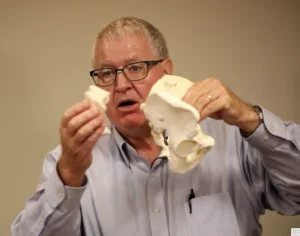
As a teacher, Dr. Hesch has trained over ten thousand clinicians. As touch is increasingly de-emphasised in physical therapy education programs, his coaching regarding hands-on work is highly valuable.
Dr. Hesch is also a researcher who expresses comprehension and facility with the work relevant to the sacroiliac joint (and entire axial skeleton). He has authored a number of publications, including the handbook included in this course, book chapters, and journal articles.
Who is the Sacroiliac Joint Specialist Certification Intended For?
The sacroiliac joint certification is intended for physical therapists and massage therapists, though it is informative and parts are within the scope of practice of Pilates, yoga, and other personal training instructors.
But a big reason that our sacroiliac joint certification review loves this course is because much of it can be practiced by non-medical health and fitness professionals, like Pilates, yoga, and dance teachers and personal trainers. The treatment in the Hesch Method is not high-velocity chiropractic adjustments, but in gentle stretches (often with a roller) that are held for around two minutes.
Glows & Grows: What we Love (and don’t!)
Our balanced Sacroiliac Joint Pain certification review considers the aspects that glow and have room to grow.
Glows (stuff we love!)
- Intelligent, well-organized, personable presentation
- Evidence-based: including lots of myth-busting
- Clinical experience: Dr. Hesch has over 40 years of clinical practice!
- Personal experience: Dr. Hesch shares about and draws upon his injuries and treatment relevant to the program
- Respectful presentation of opposing views
- Good review of contraindications
- Big handbook is an easy reference to include in the clinic
- Free advanced and updated material available upon completion of the PESI Sacroiliac Joint Specialist Certification
- You can immediately learn effective ways of treating sacroiliac and pelvic pain without completing the entire certification

This handbook is worth printing out and using as a reference. It contains:
- Description and illustrations of all exercises and tests
- Excellent literature reviews on relevant topics and big bibliography
- Illustrations for in-depth pelvic anatomy
- Handouts for client homework
Grows
Even excellent course have room for improvement. Our sacroiliac joint certification review offers a couple of small suggestions:
- A concern for any certification is ongoing research. Although the course makes commendable use of available literature as of 2020, it could be updated with findings since its original publication (e.g., Völker and Heyde’s 2022 study). Lucky for you, the free recertification course with updated material provides just that information. Also see our Busting Sacroiliac Joint Myths: an Interview with Dr. Jerry Hesch for his updated commentary on the sacroiliac joint!
Myth-busting elements
A major surprise for many may be the fact that there is actually very little movement in the sacroiliac joint. There is an average of only 2 millimeters of movement with around 2 degrees of movement in the sacroiliac joint in any direction. That means that most statements about the sacroiliac joint being out of alignment based on palpation are likely misguided.
Slips in the sacroiliac joint alone are not visible or palpable. Asymmetries in the sacroiliac joint are due to more global positions in the pelvis itself or in its relation to the low back or femurs. (Asymmetries of the pelvic bones, on the other hand, may well be visible or palpable.)
Our sacroiliac joint certification review loves that the course makes an excellent case against Grade 5, high-velocity manipulations. Instead, the Hesch Method for treating sacroiliac and related pelvic pain encourages low load, long duration stretches to encourage change in nervous system. It encourages creep and acknowledges the role of joint receptors, which enduces change soft/connective tissue over time.
Against the ubiquitous pain provocation test cluster: multiple review articles argue that these tests are too general, offer little reliability, and express infrequent tester agreement.
Gems from the Sacroiliac Joint Specialist Certification
“A much more important concept than the fact that motion must occur in the joint is the concept that motion must occur through the joint.”
Jerry W. Hesch, Treating Sacroiliac Joint Dysfunction and Lumbopelvic Pathomechanics: integrating the Sacroiliac, Pelvis, Lumbar Spine, Hips and Symphysis Pubis (2020), p. 21.


“The pelvis can go though a lot of normal motion in which [pelvic] landmarks move a great deal and yet, due to compressive loading, there is no altered position between the sacrum and the ilium/ilia within the SIJ.”
Nerding-Out: Double Spring Recoil Tests
One of the outstanding features of the Hesch Method of treating sacroiliac joint (SIJ) pain is in its use of spring tests to examine whether motion is passing through the SIJ or whether it gets blocked. Over his decades of working with SIJ pain and (and adjacent hip and low back pain), Dr. Hesch has created a method which relies nearly entirely on what he calls Double Spring Recoil Tests.
In Double Spring Recoil testing, the specialist will first “take up the slack” for a given area (here, the anterior glide along the angle of the posterior ilium). The specialist then will give an additional force to see if the joint 1) allows further movement and 2) bounces back (or recoils) after that second force.
This allows the practitioner to evaluate whether motion is passing through the joint within that plane. If not, it gives a good indication of which joint is dysfunctional.
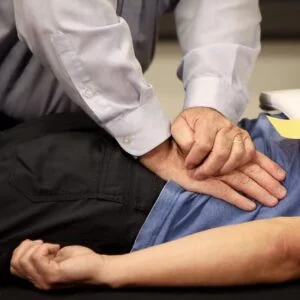
The Sacroiliac Joint Specialist certification teaches seventeen Double Spring Recoil tests as its diagnostic for sacroiliac joint pain. The handbook contains flow charts for treatment and followup testing for a variety of patterns, including:
- General hip misalignment
- The most common pattern
- Second most common pattern
- Sacral torsion
- Upslip and Downslip
The Hesch Method finds that lack of motion (hypomobility) in one area is often countered by instability (hypermobility) in a corresponding area. Treating one often resolves the other.
What is the Hesch Method?
The Hesch Method for the sacroiliac joint pain focuses on the pelvis as a whole in its relation to the lumbar spine below it and the femurs beside it.
Two features of the Hesch Method are worth considering here:
- Double Spring Recoil tests: this is a gentle testing of motion through joints to assess hypo- and hyper-mobility. PESI’s Sacroiliac Joint Specialist Certification teaches 17 of these tests to fully assess movements at all joints in the pelvis from various angles. Read more about Double Spring Recoil tests here.
- Low load, long duration stretches to encourage change in nervous system. Many other manual therapies try to treat by fast manipulations or lower duration stretches. The Hesch Method finds that longer duration allows better integration of the nervous system in the changes being introduced. Most of the treatment can be done by the client alone (after they’ve been instructed).
While the Sacroiliac Joint Specialist Certification focuses on the SIJ, the Hesch Method encompasses a full-body method that applies biomechanics, contemporary research, and clinical experience. The fundamental Hesch Method principles are applied throughout the body, from the pinkie toe to the TMJ!
Sacroiliac Joint Pain and Pain Science
How does the Sacroiliac Joint Specialist certification stand in relation to contemporary pain science? Since George Engel’s 1977 study, Pain Science has been reconsidering our understanding of what constitutes pain. Engel introduced a biopsychosocial model of pain, which considers the role not only of biology, but also the contributions of our individual psychology and social surroundings to our experience of pain. So you may be wondering whether the course is informed by pain science, or if it’s operating under outdated assumptions regarding pain.
The course is focused on the hands-on, physical treatment of clients and patients. But Dr. Hesch states in the course that he schedules two hours for initial visits with clients; most of that is listening to their experience, with only part of that first session dedicated to treatment.
Biologically-informed considerations of SIJ pain argue that 1) SIJ pain is often referred from other areas, such as the low back and 2) there are a number of pain receptors in the SIJ. The Hesch Method embraces a neuro-biomechanical model, where the role of the nervous system is included within treatment.
In general, the Sacroiliac Joint Specialist certification considers 1) whether the SIJs are doing what they should (i.e., passing along forces) and 2) if not, what treatment can be given to encourage biomechanically-sound movement? Discussions of pain are largely minimized as the focus is with encouraging the primary role of the SIJ to pass along ground reaction forces.
Conclusion
SPECIAL MARCH 2025 50% DISCOUNT! USE OUR LINKS GET THE SACROILIAC JOINT COURSE FOR ONLY $99!!
If you’d like to become knowledgeable and successful in treating sacroiliac joint pain, there’s really no better program than the Sacroiliac Joint Specialist Certification. Within a weekend of study, you’ll have the tools you need for a radically different, safe, and successful method to treating the SIJ.
The course is an excellent value: you receive:
- Up to 11.5 hours of Continuing Education Credit
- Listing as a certified provider of the Hesch Method
- 300-page book handbook
- Free access to the advanced course!
The sacroiliac joint course is an excellent value. The material is the fruit of decades of Dr. Jerry Hesch’s clinical practice and research. Careful study of the course gives practitioners a unique skillset to effectively address sacroiliac joint pain.
Frequently Asked Questions
Is sacroiliac treatment within my Scope of Practice?
The sacroiliac certification is ideal for physical therapists, occupational therapists, and licensed massage therapists. However aspects of the method for addressing sacroiliac dysfunction are within the scope of practice for Pilates and yoga teachers and most fitness instructors. This is because the richest material is in the home exercise programs for clients.
One great advantage of the Hesch Method is that its treatment does not involve bony manipulations (that is, there’s no popping or cracking of joints). Instead, it works by gentle oscillations or sustained gentle forces to engage the nervous system.
Dr. Hesch recommends medical review as well as screening of hips and lower back before screening the pelvis.
Is the Jerry Hesch Method Sacroiliac Certification recognized for Continuing Education Credits?
Physical therapists, occupational therapists, and massage therapists can earn up to 11.25 CE hours. States have different allowances.
Are there other Hesch Method Certifications Available?
You can also get CEC credits for the Hesch Method’s Cervical Spine Certification.
What are some other certifications through PESI?
PESI offers a number of certifications you can earn for general interest or continuing education credit. Here are some top recommendations:
Sources
Engel GL. The need for a new medical model: a challenge for biomedicine. Science. 1977 Apr 8;196(4286):129-36. doi: 10.1126/science.847460. PMID: 847460.
Hesch, Jerry. Sacroiliac Joint Specialist Certification: Innovative Treatment Methods for Every Type of Lumbopelvic Dysfunction (2020).
Hesch J. Treating Micromotion Hypomobility of the Atlantoaxial Joint in Patients with Whiplash Injury. In Authors: Lundgren M, Johannson L. Movement Integration – the Systemic Approach to Human Movement. Berkley, CA. North Atlantic Books. 2020: 212-22.
Hesch, Jerry. “Sacral torsion about an oblique axis: a new approach to an old problem.” Dynamic Body: Exploring Form, Expanding Function. Oklahoma City: Freedom From Pain Institute (2011): 190-231.
Hesch, Jerry, J. Aisenbrey, and J. Guarino. “Manual therapy evaluation of the pelvic joints using palpatory and articular spring tests.” American Physical Therapy Association (1990).
Miaskowski C, Blyth F, Nicosia F, Haan M, Keefe F, Smith A, Ritchie C. A biopsychosocial model of chronic pain for older adults. Pain Med. 2020 Sep 1;21(9):1793-1805.
Völker A, Steinke H, Heyde CE. The Sacroiliac Joint as a Cause of Pain – Review of the Sacroiliac Joint Morphology and Models for Pain Genesis. Z Orthop Unfall. 2022 Oct;160(5):507-516. English, German. doi: 10.1055/a-1398-6055. Epub 2021 May 3. PMID: 33940639.
Vleeming A, Schuenke MD, Masi AT, Carreiro JE, Danneels L, Willard FH. The sacroiliac joint: an overview of its anatomy, function and potential clinical implications. J Anat. 2012 Dec;221(6):537-67. doi: 10.1111/j.1469-7580.2012.01564.x. Epub 2012 Sep 19. PMID: 22994881; PMCID: PMC3512279.
